Research Proposal: Assessing Cardiovascular Diseases Effects, Sydney
VerifiedAdded on 2023/06/11
|10
|2830
|379
Report
AI Summary
This research proposal examines the effects of cardiovascular diseases (CVD) on older adults in Sydney, Australia, addressing the significant burden of deaths and associated costs. It identifies key risk factors such as smoking, obesity, physical inactivity, poor diet, and high blood pressure. The study aims to understand the impact of CVD on individuals, families, and the economy, proposing mitigation measures and prevention strategies through lifestyle changes and dietary improvements. Data collection methods include literature reviews, observations, interviews, and questionnaires, with descriptive analysis and tables used for data presentation. The research emphasizes the importance of early detection, adherence to medication, and community awareness to reduce the adverse effects of CVD and improve patient care. Desklib provides access to similar research documents and solved assignments for students.
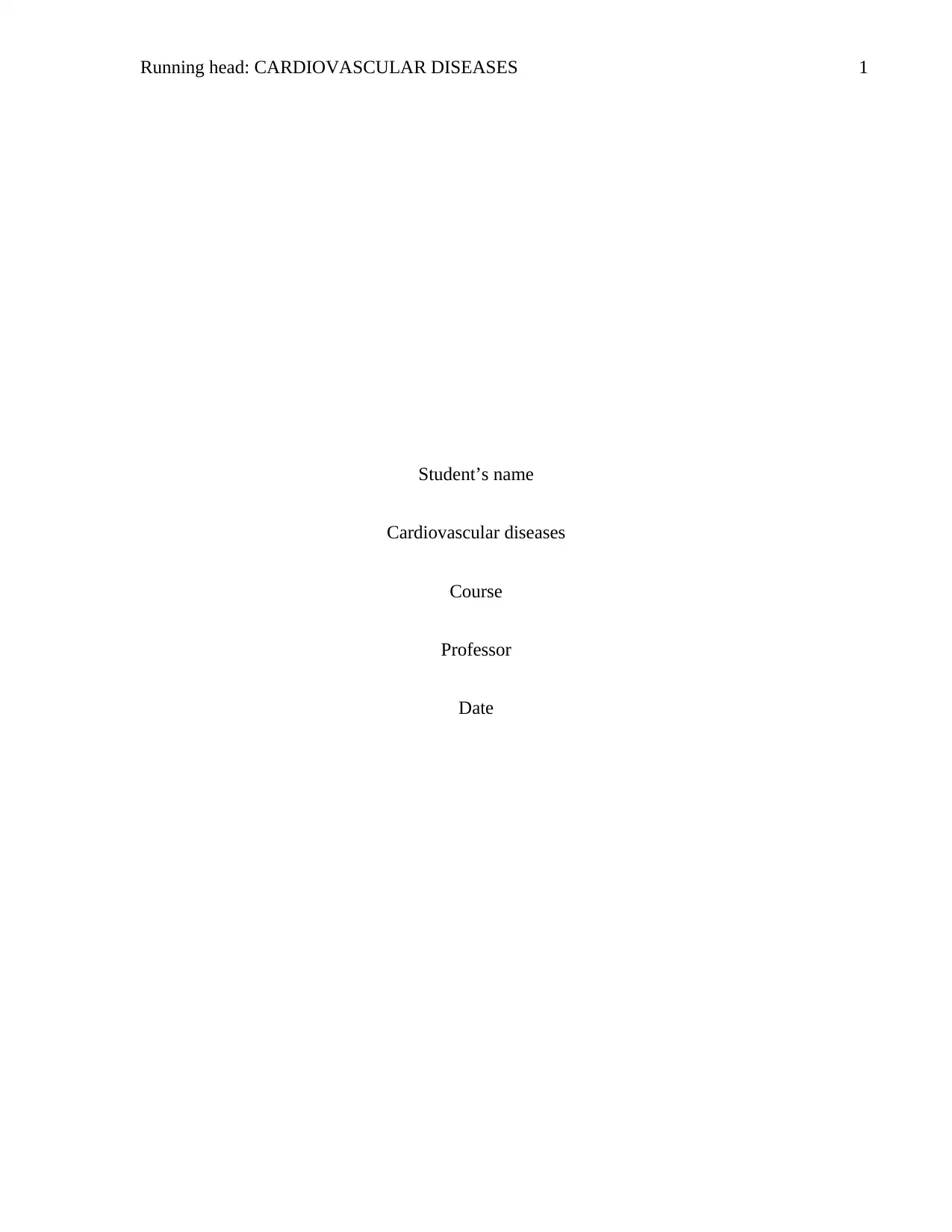
Running head: CARDIOVASCULAR DISEASES 1
Student’s name
Cardiovascular diseases
Course
Professor
Date
Student’s name
Cardiovascular diseases
Course
Professor
Date
Paraphrase This Document
Need a fresh take? Get an instant paraphrase of this document with our AI Paraphraser
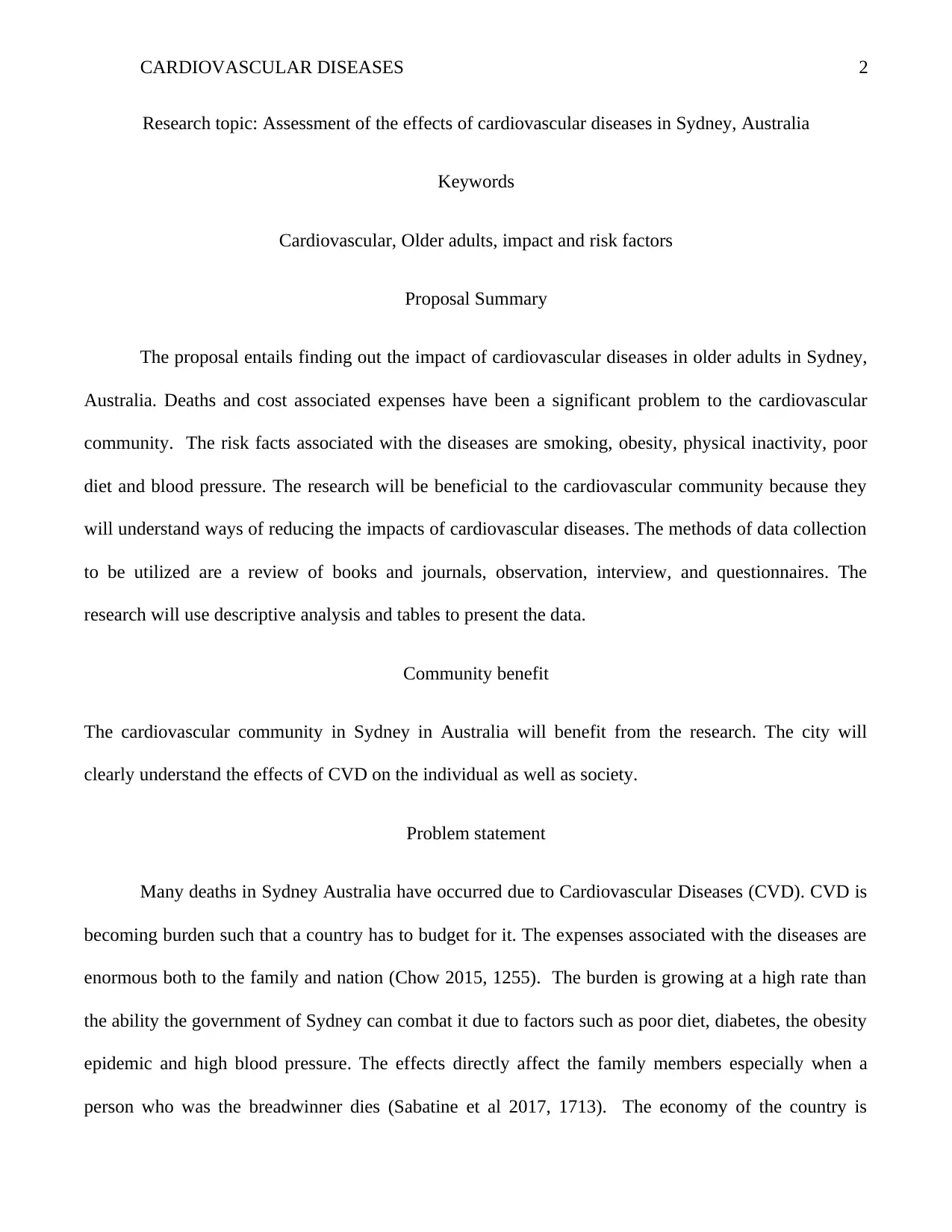
CARDIOVASCULAR DISEASES 2
Research topic: Assessment of the effects of cardiovascular diseases in Sydney, Australia
Keywords
Cardiovascular, Older adults, impact and risk factors
Proposal Summary
The proposal entails finding out the impact of cardiovascular diseases in older adults in Sydney,
Australia. Deaths and cost associated expenses have been a significant problem to the cardiovascular
community. The risk facts associated with the diseases are smoking, obesity, physical inactivity, poor
diet and blood pressure. The research will be beneficial to the cardiovascular community because they
will understand ways of reducing the impacts of cardiovascular diseases. The methods of data collection
to be utilized are a review of books and journals, observation, interview, and questionnaires. The
research will use descriptive analysis and tables to present the data.
Community benefit
The cardiovascular community in Sydney in Australia will benefit from the research. The city will
clearly understand the effects of CVD on the individual as well as society.
Problem statement
Many deaths in Sydney Australia have occurred due to Cardiovascular Diseases (CVD). CVD is
becoming burden such that a country has to budget for it. The expenses associated with the diseases are
enormous both to the family and nation (Chow 2015, 1255). The burden is growing at a high rate than
the ability the government of Sydney can combat it due to factors such as poor diet, diabetes, the obesity
epidemic and high blood pressure. The effects directly affect the family members especially when a
person who was the breadwinner dies (Sabatine et al 2017, 1713). The economy of the country is
Research topic: Assessment of the effects of cardiovascular diseases in Sydney, Australia
Keywords
Cardiovascular, Older adults, impact and risk factors
Proposal Summary
The proposal entails finding out the impact of cardiovascular diseases in older adults in Sydney,
Australia. Deaths and cost associated expenses have been a significant problem to the cardiovascular
community. The risk facts associated with the diseases are smoking, obesity, physical inactivity, poor
diet and blood pressure. The research will be beneficial to the cardiovascular community because they
will understand ways of reducing the impacts of cardiovascular diseases. The methods of data collection
to be utilized are a review of books and journals, observation, interview, and questionnaires. The
research will use descriptive analysis and tables to present the data.
Community benefit
The cardiovascular community in Sydney in Australia will benefit from the research. The city will
clearly understand the effects of CVD on the individual as well as society.
Problem statement
Many deaths in Sydney Australia have occurred due to Cardiovascular Diseases (CVD). CVD is
becoming burden such that a country has to budget for it. The expenses associated with the diseases are
enormous both to the family and nation (Chow 2015, 1255). The burden is growing at a high rate than
the ability the government of Sydney can combat it due to factors such as poor diet, diabetes, the obesity
epidemic and high blood pressure. The effects directly affect the family members especially when a
person who was the breadwinner dies (Sabatine et al 2017, 1713). The economy of the country is
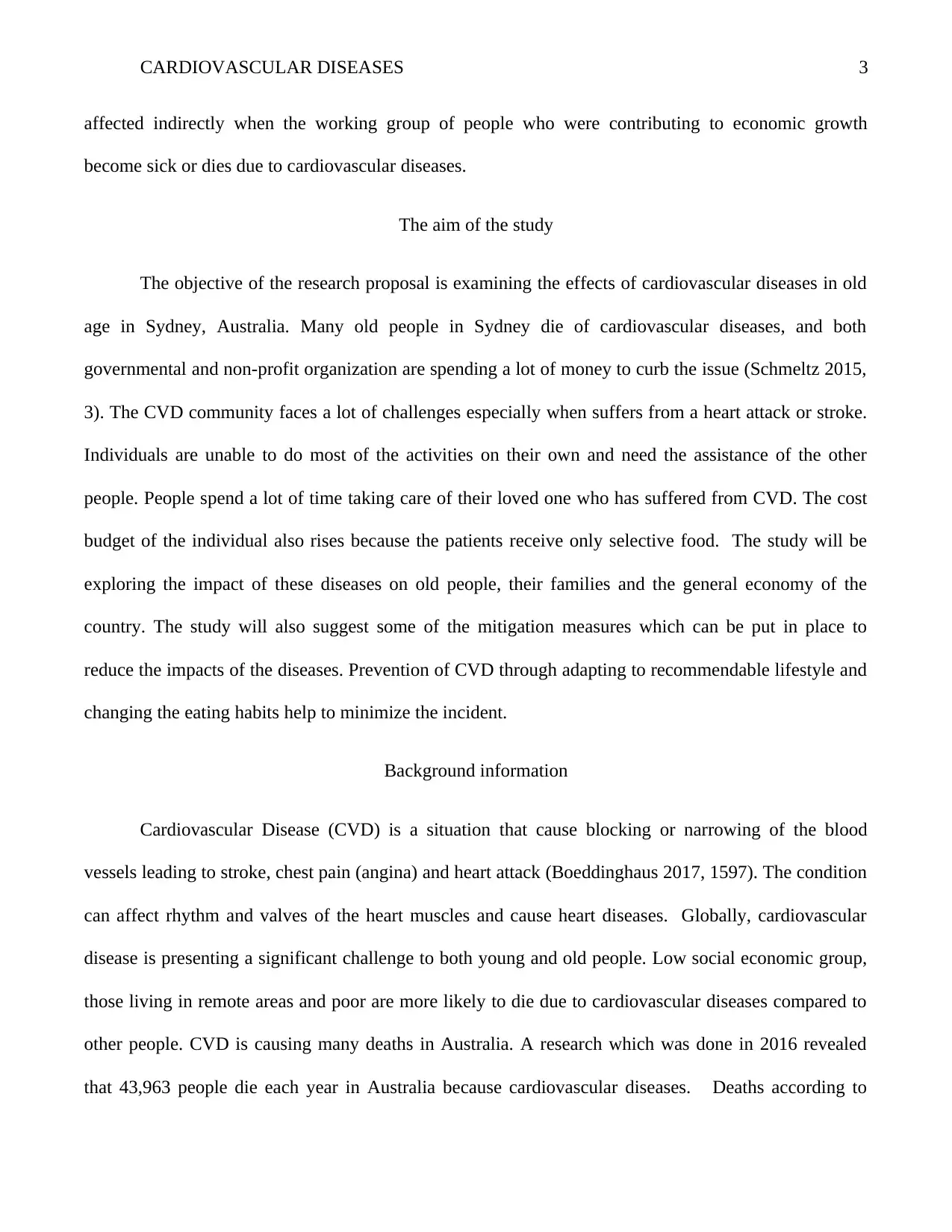
CARDIOVASCULAR DISEASES 3
affected indirectly when the working group of people who were contributing to economic growth
become sick or dies due to cardiovascular diseases.
The aim of the study
The objective of the research proposal is examining the effects of cardiovascular diseases in old
age in Sydney, Australia. Many old people in Sydney die of cardiovascular diseases, and both
governmental and non-profit organization are spending a lot of money to curb the issue (Schmeltz 2015,
3). The CVD community faces a lot of challenges especially when suffers from a heart attack or stroke.
Individuals are unable to do most of the activities on their own and need the assistance of the other
people. People spend a lot of time taking care of their loved one who has suffered from CVD. The cost
budget of the individual also rises because the patients receive only selective food. The study will be
exploring the impact of these diseases on old people, their families and the general economy of the
country. The study will also suggest some of the mitigation measures which can be put in place to
reduce the impacts of the diseases. Prevention of CVD through adapting to recommendable lifestyle and
changing the eating habits help to minimize the incident.
Background information
Cardiovascular Disease (CVD) is a situation that cause blocking or narrowing of the blood
vessels leading to stroke, chest pain (angina) and heart attack (Boeddinghaus 2017, 1597). The condition
can affect rhythm and valves of the heart muscles and cause heart diseases. Globally, cardiovascular
disease is presenting a significant challenge to both young and old people. Low social economic group,
those living in remote areas and poor are more likely to die due to cardiovascular diseases compared to
other people. CVD is causing many deaths in Australia. A research which was done in 2016 revealed
that 43,963 people die each year in Australia because cardiovascular diseases. Deaths according to
affected indirectly when the working group of people who were contributing to economic growth
become sick or dies due to cardiovascular diseases.
The aim of the study
The objective of the research proposal is examining the effects of cardiovascular diseases in old
age in Sydney, Australia. Many old people in Sydney die of cardiovascular diseases, and both
governmental and non-profit organization are spending a lot of money to curb the issue (Schmeltz 2015,
3). The CVD community faces a lot of challenges especially when suffers from a heart attack or stroke.
Individuals are unable to do most of the activities on their own and need the assistance of the other
people. People spend a lot of time taking care of their loved one who has suffered from CVD. The cost
budget of the individual also rises because the patients receive only selective food. The study will be
exploring the impact of these diseases on old people, their families and the general economy of the
country. The study will also suggest some of the mitigation measures which can be put in place to
reduce the impacts of the diseases. Prevention of CVD through adapting to recommendable lifestyle and
changing the eating habits help to minimize the incident.
Background information
Cardiovascular Disease (CVD) is a situation that cause blocking or narrowing of the blood
vessels leading to stroke, chest pain (angina) and heart attack (Boeddinghaus 2017, 1597). The condition
can affect rhythm and valves of the heart muscles and cause heart diseases. Globally, cardiovascular
disease is presenting a significant challenge to both young and old people. Low social economic group,
those living in remote areas and poor are more likely to die due to cardiovascular diseases compared to
other people. CVD is causing many deaths in Australia. A research which was done in 2016 revealed
that 43,963 people die each year in Australia because cardiovascular diseases. Deaths according to
⊘ This is a preview!⊘
Do you want full access?
Subscribe today to unlock all pages.

Trusted by 1+ million students worldwide
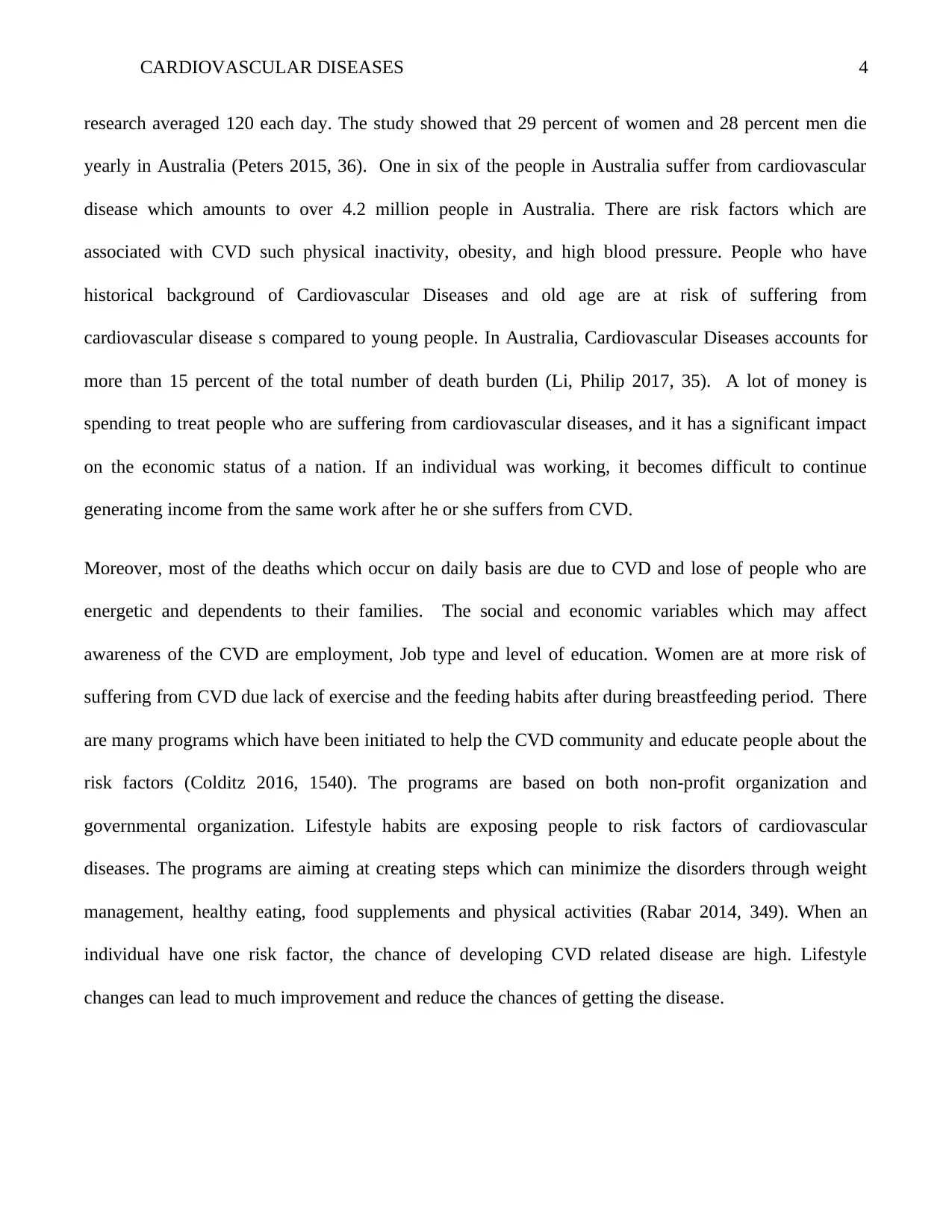
CARDIOVASCULAR DISEASES 4
research averaged 120 each day. The study showed that 29 percent of women and 28 percent men die
yearly in Australia (Peters 2015, 36). One in six of the people in Australia suffer from cardiovascular
disease which amounts to over 4.2 million people in Australia. There are risk factors which are
associated with CVD such physical inactivity, obesity, and high blood pressure. People who have
historical background of Cardiovascular Diseases and old age are at risk of suffering from
cardiovascular disease s compared to young people. In Australia, Cardiovascular Diseases accounts for
more than 15 percent of the total number of death burden (Li, Philip 2017, 35). A lot of money is
spending to treat people who are suffering from cardiovascular diseases, and it has a significant impact
on the economic status of a nation. If an individual was working, it becomes difficult to continue
generating income from the same work after he or she suffers from CVD.
Moreover, most of the deaths which occur on daily basis are due to CVD and lose of people who are
energetic and dependents to their families. The social and economic variables which may affect
awareness of the CVD are employment, Job type and level of education. Women are at more risk of
suffering from CVD due lack of exercise and the feeding habits after during breastfeeding period. There
are many programs which have been initiated to help the CVD community and educate people about the
risk factors (Colditz 2016, 1540). The programs are based on both non-profit organization and
governmental organization. Lifestyle habits are exposing people to risk factors of cardiovascular
diseases. The programs are aiming at creating steps which can minimize the disorders through weight
management, healthy eating, food supplements and physical activities (Rabar 2014, 349). When an
individual have one risk factor, the chance of developing CVD related disease are high. Lifestyle
changes can lead to much improvement and reduce the chances of getting the disease.
research averaged 120 each day. The study showed that 29 percent of women and 28 percent men die
yearly in Australia (Peters 2015, 36). One in six of the people in Australia suffer from cardiovascular
disease which amounts to over 4.2 million people in Australia. There are risk factors which are
associated with CVD such physical inactivity, obesity, and high blood pressure. People who have
historical background of Cardiovascular Diseases and old age are at risk of suffering from
cardiovascular disease s compared to young people. In Australia, Cardiovascular Diseases accounts for
more than 15 percent of the total number of death burden (Li, Philip 2017, 35). A lot of money is
spending to treat people who are suffering from cardiovascular diseases, and it has a significant impact
on the economic status of a nation. If an individual was working, it becomes difficult to continue
generating income from the same work after he or she suffers from CVD.
Moreover, most of the deaths which occur on daily basis are due to CVD and lose of people who are
energetic and dependents to their families. The social and economic variables which may affect
awareness of the CVD are employment, Job type and level of education. Women are at more risk of
suffering from CVD due lack of exercise and the feeding habits after during breastfeeding period. There
are many programs which have been initiated to help the CVD community and educate people about the
risk factors (Colditz 2016, 1540). The programs are based on both non-profit organization and
governmental organization. Lifestyle habits are exposing people to risk factors of cardiovascular
diseases. The programs are aiming at creating steps which can minimize the disorders through weight
management, healthy eating, food supplements and physical activities (Rabar 2014, 349). When an
individual have one risk factor, the chance of developing CVD related disease are high. Lifestyle
changes can lead to much improvement and reduce the chances of getting the disease.
Paraphrase This Document
Need a fresh take? Get an instant paraphrase of this document with our AI Paraphraser
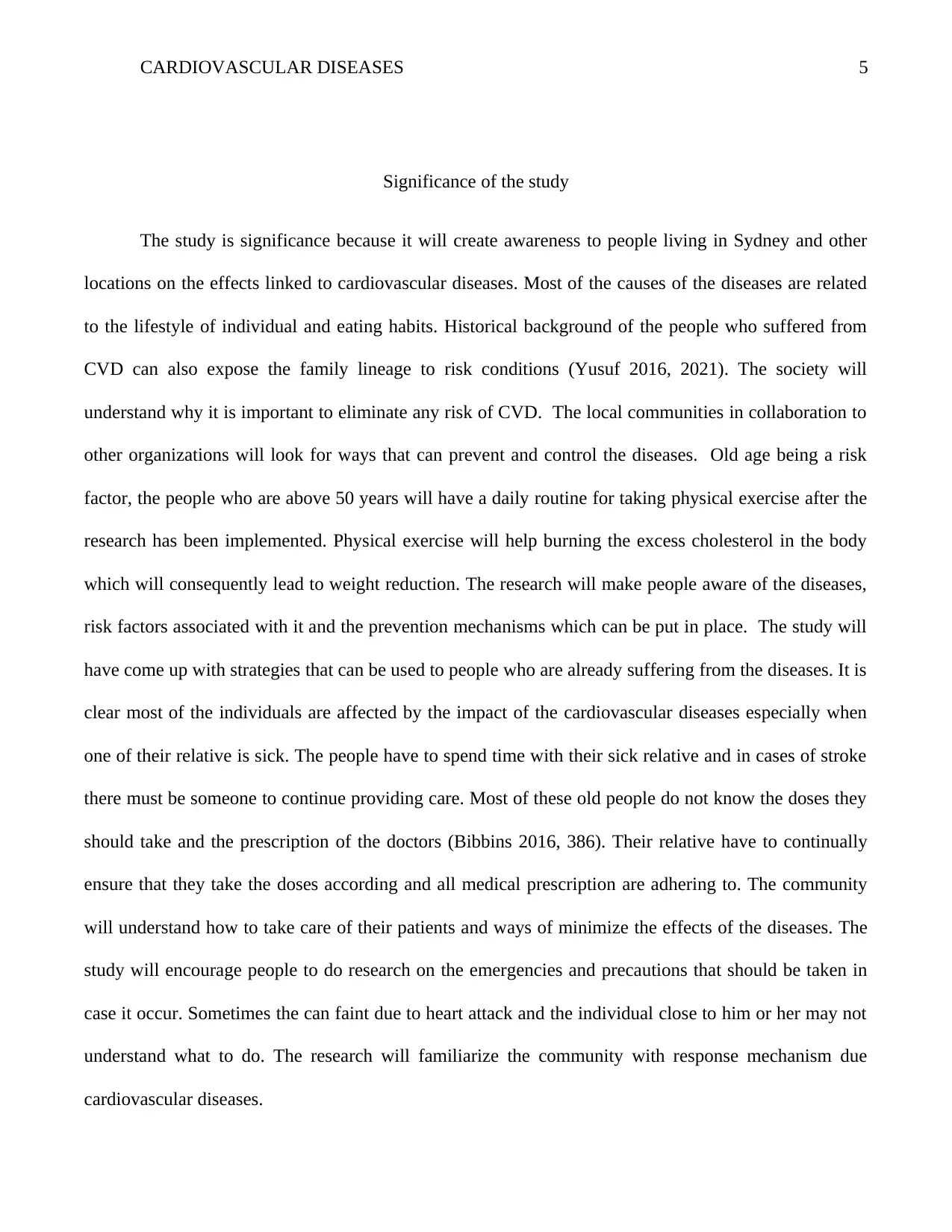
CARDIOVASCULAR DISEASES 5
Significance of the study
The study is significance because it will create awareness to people living in Sydney and other
locations on the effects linked to cardiovascular diseases. Most of the causes of the diseases are related
to the lifestyle of individual and eating habits. Historical background of the people who suffered from
CVD can also expose the family lineage to risk conditions (Yusuf 2016, 2021). The society will
understand why it is important to eliminate any risk of CVD. The local communities in collaboration to
other organizations will look for ways that can prevent and control the diseases. Old age being a risk
factor, the people who are above 50 years will have a daily routine for taking physical exercise after the
research has been implemented. Physical exercise will help burning the excess cholesterol in the body
which will consequently lead to weight reduction. The research will make people aware of the diseases,
risk factors associated with it and the prevention mechanisms which can be put in place. The study will
have come up with strategies that can be used to people who are already suffering from the diseases. It is
clear most of the individuals are affected by the impact of the cardiovascular diseases especially when
one of their relative is sick. The people have to spend time with their sick relative and in cases of stroke
there must be someone to continue providing care. Most of these old people do not know the doses they
should take and the prescription of the doctors (Bibbins 2016, 386). Their relative have to continually
ensure that they take the doses according and all medical prescription are adhering to. The community
will understand how to take care of their patients and ways of minimize the effects of the diseases. The
study will encourage people to do research on the emergencies and precautions that should be taken in
case it occur. Sometimes the can faint due to heart attack and the individual close to him or her may not
understand what to do. The research will familiarize the community with response mechanism due
cardiovascular diseases.
Significance of the study
The study is significance because it will create awareness to people living in Sydney and other
locations on the effects linked to cardiovascular diseases. Most of the causes of the diseases are related
to the lifestyle of individual and eating habits. Historical background of the people who suffered from
CVD can also expose the family lineage to risk conditions (Yusuf 2016, 2021). The society will
understand why it is important to eliminate any risk of CVD. The local communities in collaboration to
other organizations will look for ways that can prevent and control the diseases. Old age being a risk
factor, the people who are above 50 years will have a daily routine for taking physical exercise after the
research has been implemented. Physical exercise will help burning the excess cholesterol in the body
which will consequently lead to weight reduction. The research will make people aware of the diseases,
risk factors associated with it and the prevention mechanisms which can be put in place. The study will
have come up with strategies that can be used to people who are already suffering from the diseases. It is
clear most of the individuals are affected by the impact of the cardiovascular diseases especially when
one of their relative is sick. The people have to spend time with their sick relative and in cases of stroke
there must be someone to continue providing care. Most of these old people do not know the doses they
should take and the prescription of the doctors (Bibbins 2016, 386). Their relative have to continually
ensure that they take the doses according and all medical prescription are adhering to. The community
will understand how to take care of their patients and ways of minimize the effects of the diseases. The
study will encourage people to do research on the emergencies and precautions that should be taken in
case it occur. Sometimes the can faint due to heart attack and the individual close to him or her may not
understand what to do. The research will familiarize the community with response mechanism due
cardiovascular diseases.
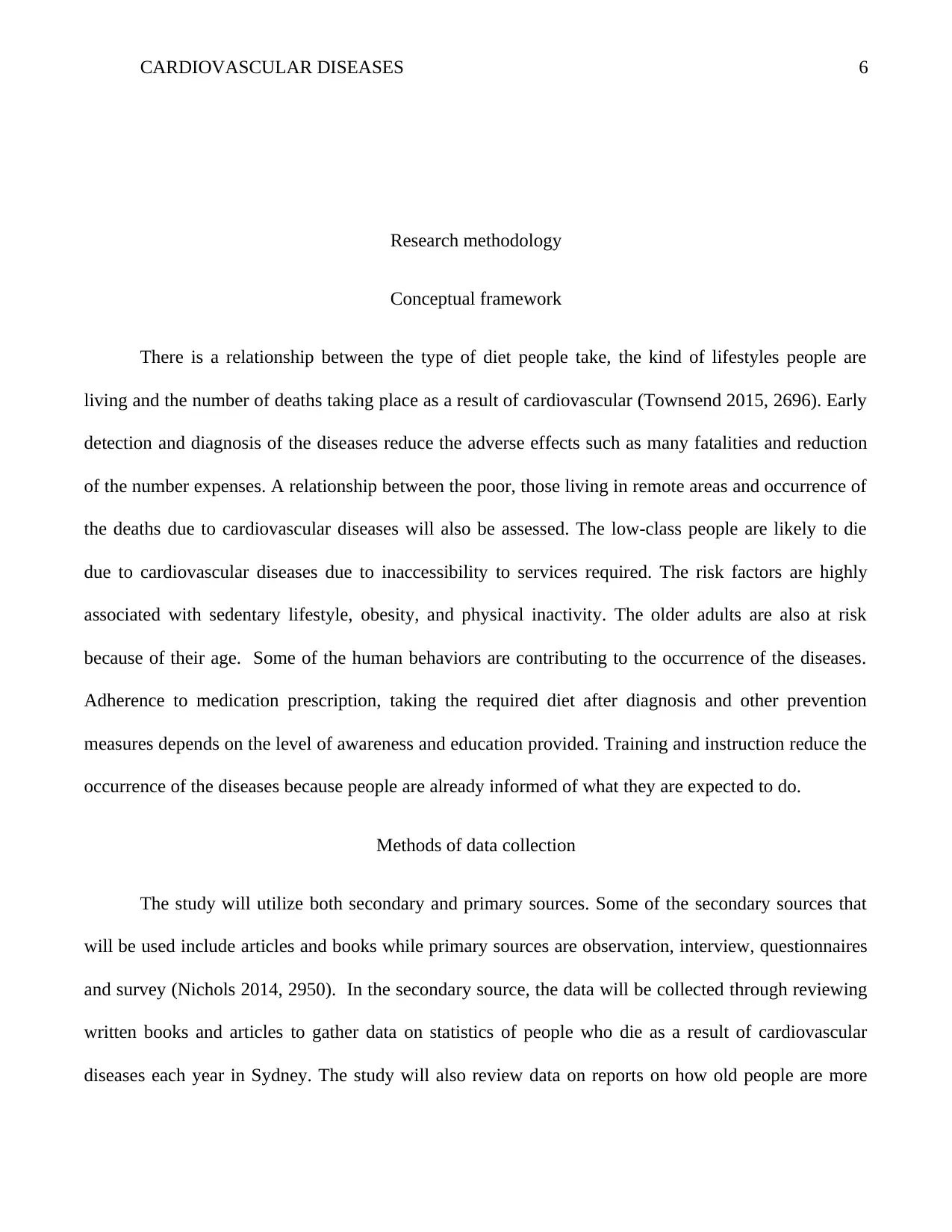
CARDIOVASCULAR DISEASES 6
Research methodology
Conceptual framework
There is a relationship between the type of diet people take, the kind of lifestyles people are
living and the number of deaths taking place as a result of cardiovascular (Townsend 2015, 2696). Early
detection and diagnosis of the diseases reduce the adverse effects such as many fatalities and reduction
of the number expenses. A relationship between the poor, those living in remote areas and occurrence of
the deaths due to cardiovascular diseases will also be assessed. The low-class people are likely to die
due to cardiovascular diseases due to inaccessibility to services required. The risk factors are highly
associated with sedentary lifestyle, obesity, and physical inactivity. The older adults are also at risk
because of their age. Some of the human behaviors are contributing to the occurrence of the diseases.
Adherence to medication prescription, taking the required diet after diagnosis and other prevention
measures depends on the level of awareness and education provided. Training and instruction reduce the
occurrence of the diseases because people are already informed of what they are expected to do.
Methods of data collection
The study will utilize both secondary and primary sources. Some of the secondary sources that
will be used include articles and books while primary sources are observation, interview, questionnaires
and survey (Nichols 2014, 2950). In the secondary source, the data will be collected through reviewing
written books and articles to gather data on statistics of people who die as a result of cardiovascular
diseases each year in Sydney. The study will also review data on reports on how old people are more
Research methodology
Conceptual framework
There is a relationship between the type of diet people take, the kind of lifestyles people are
living and the number of deaths taking place as a result of cardiovascular (Townsend 2015, 2696). Early
detection and diagnosis of the diseases reduce the adverse effects such as many fatalities and reduction
of the number expenses. A relationship between the poor, those living in remote areas and occurrence of
the deaths due to cardiovascular diseases will also be assessed. The low-class people are likely to die
due to cardiovascular diseases due to inaccessibility to services required. The risk factors are highly
associated with sedentary lifestyle, obesity, and physical inactivity. The older adults are also at risk
because of their age. Some of the human behaviors are contributing to the occurrence of the diseases.
Adherence to medication prescription, taking the required diet after diagnosis and other prevention
measures depends on the level of awareness and education provided. Training and instruction reduce the
occurrence of the diseases because people are already informed of what they are expected to do.
Methods of data collection
The study will utilize both secondary and primary sources. Some of the secondary sources that
will be used include articles and books while primary sources are observation, interview, questionnaires
and survey (Nichols 2014, 2950). In the secondary source, the data will be collected through reviewing
written books and articles to gather data on statistics of people who die as a result of cardiovascular
diseases each year in Sydney. The study will also review data on reports on how old people are more
⊘ This is a preview!⊘
Do you want full access?
Subscribe today to unlock all pages.

Trusted by 1+ million students worldwide
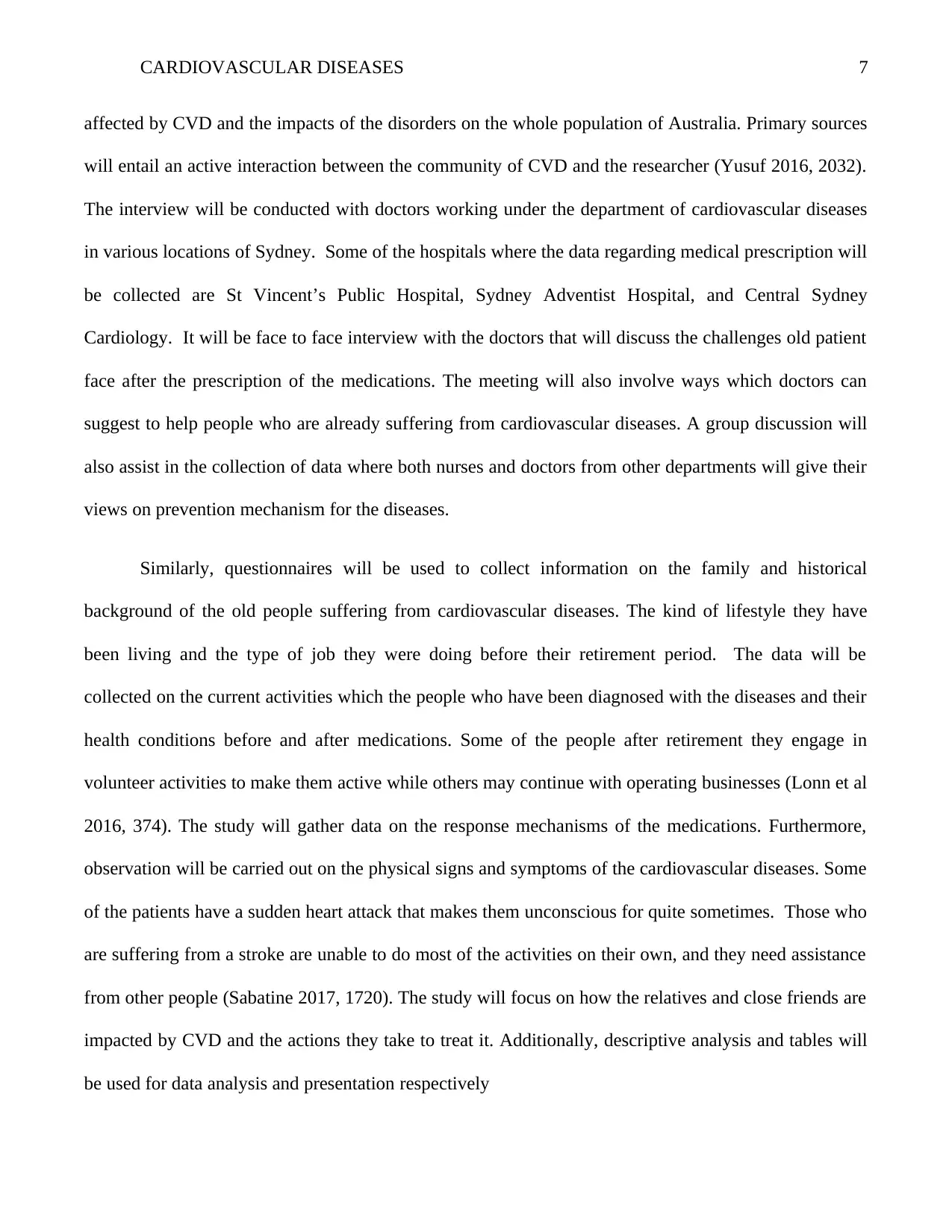
CARDIOVASCULAR DISEASES 7
affected by CVD and the impacts of the disorders on the whole population of Australia. Primary sources
will entail an active interaction between the community of CVD and the researcher (Yusuf 2016, 2032).
The interview will be conducted with doctors working under the department of cardiovascular diseases
in various locations of Sydney. Some of the hospitals where the data regarding medical prescription will
be collected are St Vincent’s Public Hospital, Sydney Adventist Hospital, and Central Sydney
Cardiology. It will be face to face interview with the doctors that will discuss the challenges old patient
face after the prescription of the medications. The meeting will also involve ways which doctors can
suggest to help people who are already suffering from cardiovascular diseases. A group discussion will
also assist in the collection of data where both nurses and doctors from other departments will give their
views on prevention mechanism for the diseases.
Similarly, questionnaires will be used to collect information on the family and historical
background of the old people suffering from cardiovascular diseases. The kind of lifestyle they have
been living and the type of job they were doing before their retirement period. The data will be
collected on the current activities which the people who have been diagnosed with the diseases and their
health conditions before and after medications. Some of the people after retirement they engage in
volunteer activities to make them active while others may continue with operating businesses (Lonn et al
2016, 374). The study will gather data on the response mechanisms of the medications. Furthermore,
observation will be carried out on the physical signs and symptoms of the cardiovascular diseases. Some
of the patients have a sudden heart attack that makes them unconscious for quite sometimes. Those who
are suffering from a stroke are unable to do most of the activities on their own, and they need assistance
from other people (Sabatine 2017, 1720). The study will focus on how the relatives and close friends are
impacted by CVD and the actions they take to treat it. Additionally, descriptive analysis and tables will
be used for data analysis and presentation respectively
affected by CVD and the impacts of the disorders on the whole population of Australia. Primary sources
will entail an active interaction between the community of CVD and the researcher (Yusuf 2016, 2032).
The interview will be conducted with doctors working under the department of cardiovascular diseases
in various locations of Sydney. Some of the hospitals where the data regarding medical prescription will
be collected are St Vincent’s Public Hospital, Sydney Adventist Hospital, and Central Sydney
Cardiology. It will be face to face interview with the doctors that will discuss the challenges old patient
face after the prescription of the medications. The meeting will also involve ways which doctors can
suggest to help people who are already suffering from cardiovascular diseases. A group discussion will
also assist in the collection of data where both nurses and doctors from other departments will give their
views on prevention mechanism for the diseases.
Similarly, questionnaires will be used to collect information on the family and historical
background of the old people suffering from cardiovascular diseases. The kind of lifestyle they have
been living and the type of job they were doing before their retirement period. The data will be
collected on the current activities which the people who have been diagnosed with the diseases and their
health conditions before and after medications. Some of the people after retirement they engage in
volunteer activities to make them active while others may continue with operating businesses (Lonn et al
2016, 374). The study will gather data on the response mechanisms of the medications. Furthermore,
observation will be carried out on the physical signs and symptoms of the cardiovascular diseases. Some
of the patients have a sudden heart attack that makes them unconscious for quite sometimes. Those who
are suffering from a stroke are unable to do most of the activities on their own, and they need assistance
from other people (Sabatine 2017, 1720). The study will focus on how the relatives and close friends are
impacted by CVD and the actions they take to treat it. Additionally, descriptive analysis and tables will
be used for data analysis and presentation respectively
Paraphrase This Document
Need a fresh take? Get an instant paraphrase of this document with our AI Paraphraser
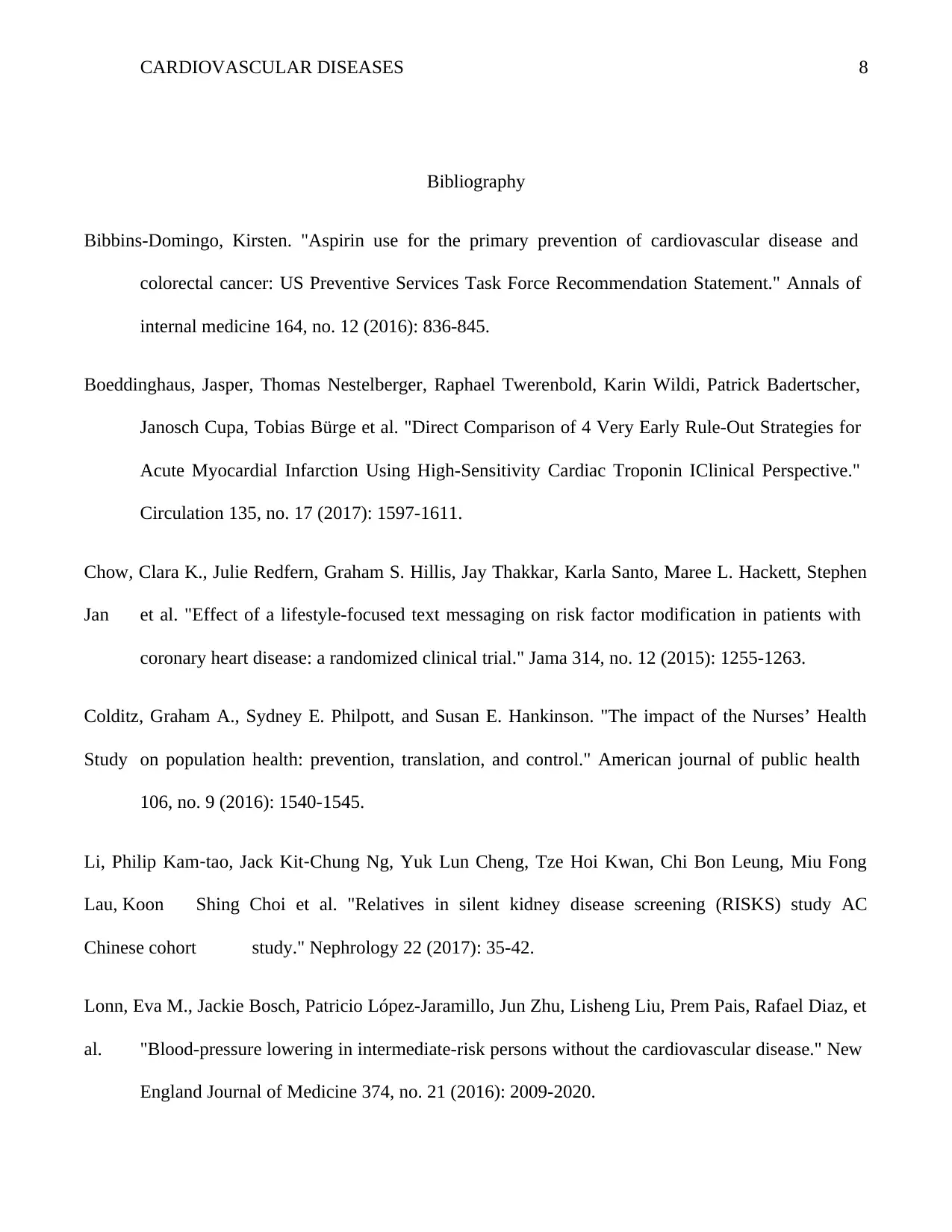
CARDIOVASCULAR DISEASES 8
Bibliography
Bibbins-Domingo, Kirsten. "Aspirin use for the primary prevention of cardiovascular disease and
colorectal cancer: US Preventive Services Task Force Recommendation Statement." Annals of
internal medicine 164, no. 12 (2016): 836-845.
Boeddinghaus, Jasper, Thomas Nestelberger, Raphael Twerenbold, Karin Wildi, Patrick Badertscher,
Janosch Cupa, Tobias Bürge et al. "Direct Comparison of 4 Very Early Rule-Out Strategies for
Acute Myocardial Infarction Using High-Sensitivity Cardiac Troponin IClinical Perspective."
Circulation 135, no. 17 (2017): 1597-1611.
Chow, Clara K., Julie Redfern, Graham S. Hillis, Jay Thakkar, Karla Santo, Maree L. Hackett, Stephen
Jan et al. "Effect of a lifestyle-focused text messaging on risk factor modification in patients with
coronary heart disease: a randomized clinical trial." Jama 314, no. 12 (2015): 1255-1263.
Colditz, Graham A., Sydney E. Philpott, and Susan E. Hankinson. "The impact of the Nurses’ Health
Study on population health: prevention, translation, and control." American journal of public health
106, no. 9 (2016): 1540-1545.
Li, Philip Kam‐tao, Jack Kit‐Chung Ng, Yuk Lun Cheng, Tze Hoi Kwan, Chi Bon Leung, Miu Fong
Lau, Koon Shing Choi et al. "Relatives in silent kidney disease screening (RISKS) study AC
Chinese cohort study." Nephrology 22 (2017): 35-42.
Lonn, Eva M., Jackie Bosch, Patricio López-Jaramillo, Jun Zhu, Lisheng Liu, Prem Pais, Rafael Diaz, et
al. "Blood-pressure lowering in intermediate-risk persons without the cardiovascular disease." New
England Journal of Medicine 374, no. 21 (2016): 2009-2020.
Bibliography
Bibbins-Domingo, Kirsten. "Aspirin use for the primary prevention of cardiovascular disease and
colorectal cancer: US Preventive Services Task Force Recommendation Statement." Annals of
internal medicine 164, no. 12 (2016): 836-845.
Boeddinghaus, Jasper, Thomas Nestelberger, Raphael Twerenbold, Karin Wildi, Patrick Badertscher,
Janosch Cupa, Tobias Bürge et al. "Direct Comparison of 4 Very Early Rule-Out Strategies for
Acute Myocardial Infarction Using High-Sensitivity Cardiac Troponin IClinical Perspective."
Circulation 135, no. 17 (2017): 1597-1611.
Chow, Clara K., Julie Redfern, Graham S. Hillis, Jay Thakkar, Karla Santo, Maree L. Hackett, Stephen
Jan et al. "Effect of a lifestyle-focused text messaging on risk factor modification in patients with
coronary heart disease: a randomized clinical trial." Jama 314, no. 12 (2015): 1255-1263.
Colditz, Graham A., Sydney E. Philpott, and Susan E. Hankinson. "The impact of the Nurses’ Health
Study on population health: prevention, translation, and control." American journal of public health
106, no. 9 (2016): 1540-1545.
Li, Philip Kam‐tao, Jack Kit‐Chung Ng, Yuk Lun Cheng, Tze Hoi Kwan, Chi Bon Leung, Miu Fong
Lau, Koon Shing Choi et al. "Relatives in silent kidney disease screening (RISKS) study AC
Chinese cohort study." Nephrology 22 (2017): 35-42.
Lonn, Eva M., Jackie Bosch, Patricio López-Jaramillo, Jun Zhu, Lisheng Liu, Prem Pais, Rafael Diaz, et
al. "Blood-pressure lowering in intermediate-risk persons without the cardiovascular disease." New
England Journal of Medicine 374, no. 21 (2016): 2009-2020.
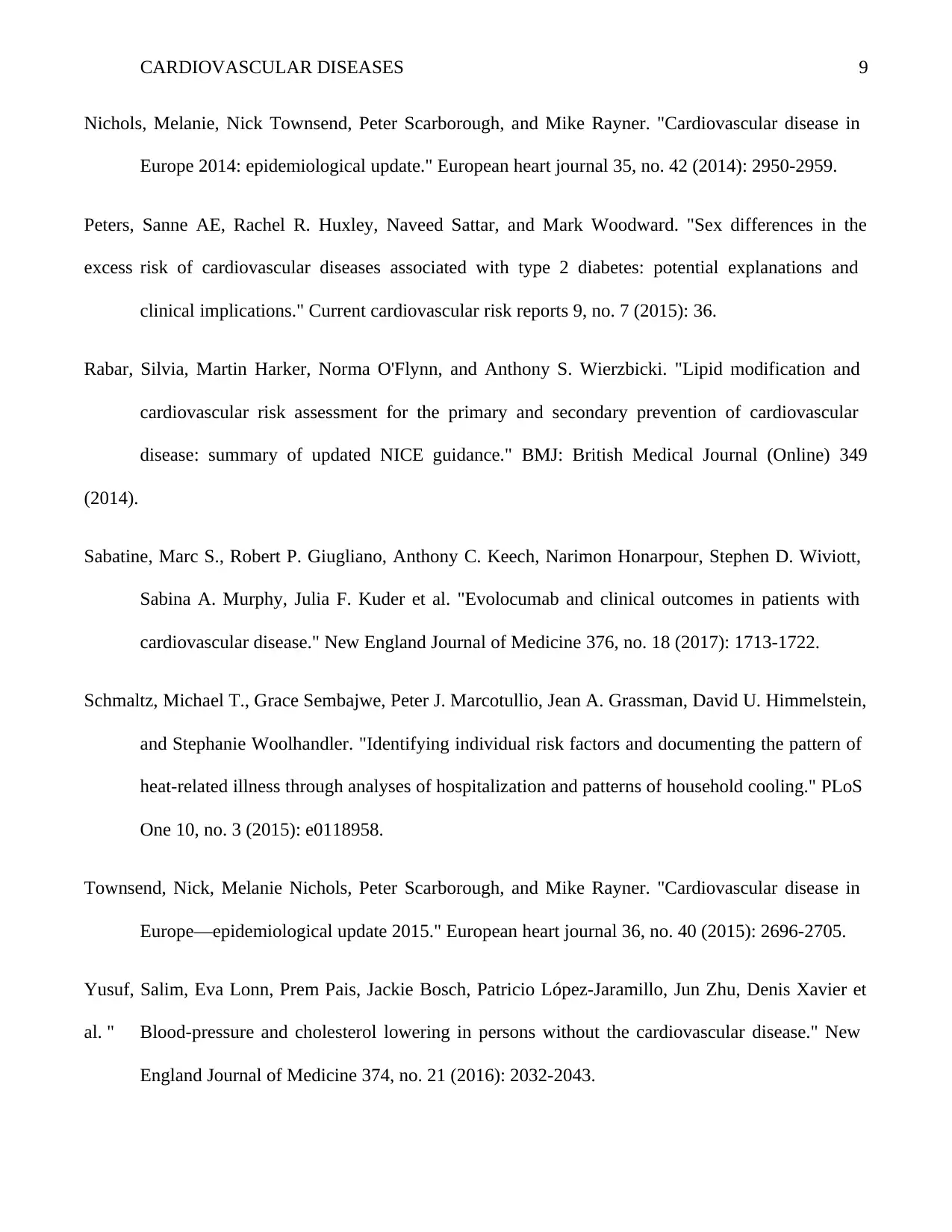
CARDIOVASCULAR DISEASES 9
Nichols, Melanie, Nick Townsend, Peter Scarborough, and Mike Rayner. "Cardiovascular disease in
Europe 2014: epidemiological update." European heart journal 35, no. 42 (2014): 2950-2959.
Peters, Sanne AE, Rachel R. Huxley, Naveed Sattar, and Mark Woodward. "Sex differences in the
excess risk of cardiovascular diseases associated with type 2 diabetes: potential explanations and
clinical implications." Current cardiovascular risk reports 9, no. 7 (2015): 36.
Rabar, Silvia, Martin Harker, Norma O'Flynn, and Anthony S. Wierzbicki. "Lipid modification and
cardiovascular risk assessment for the primary and secondary prevention of cardiovascular
disease: summary of updated NICE guidance." BMJ: British Medical Journal (Online) 349
(2014).
Sabatine, Marc S., Robert P. Giugliano, Anthony C. Keech, Narimon Honarpour, Stephen D. Wiviott,
Sabina A. Murphy, Julia F. Kuder et al. "Evolocumab and clinical outcomes in patients with
cardiovascular disease." New England Journal of Medicine 376, no. 18 (2017): 1713-1722.
Schmaltz, Michael T., Grace Sembajwe, Peter J. Marcotullio, Jean A. Grassman, David U. Himmelstein,
and Stephanie Woolhandler. "Identifying individual risk factors and documenting the pattern of
heat-related illness through analyses of hospitalization and patterns of household cooling." PLoS
One 10, no. 3 (2015): e0118958.
Townsend, Nick, Melanie Nichols, Peter Scarborough, and Mike Rayner. "Cardiovascular disease in
Europe—epidemiological update 2015." European heart journal 36, no. 40 (2015): 2696-2705.
Yusuf, Salim, Eva Lonn, Prem Pais, Jackie Bosch, Patricio López-Jaramillo, Jun Zhu, Denis Xavier et
al. " Blood-pressure and cholesterol lowering in persons without the cardiovascular disease." New
England Journal of Medicine 374, no. 21 (2016): 2032-2043.
Nichols, Melanie, Nick Townsend, Peter Scarborough, and Mike Rayner. "Cardiovascular disease in
Europe 2014: epidemiological update." European heart journal 35, no. 42 (2014): 2950-2959.
Peters, Sanne AE, Rachel R. Huxley, Naveed Sattar, and Mark Woodward. "Sex differences in the
excess risk of cardiovascular diseases associated with type 2 diabetes: potential explanations and
clinical implications." Current cardiovascular risk reports 9, no. 7 (2015): 36.
Rabar, Silvia, Martin Harker, Norma O'Flynn, and Anthony S. Wierzbicki. "Lipid modification and
cardiovascular risk assessment for the primary and secondary prevention of cardiovascular
disease: summary of updated NICE guidance." BMJ: British Medical Journal (Online) 349
(2014).
Sabatine, Marc S., Robert P. Giugliano, Anthony C. Keech, Narimon Honarpour, Stephen D. Wiviott,
Sabina A. Murphy, Julia F. Kuder et al. "Evolocumab and clinical outcomes in patients with
cardiovascular disease." New England Journal of Medicine 376, no. 18 (2017): 1713-1722.
Schmaltz, Michael T., Grace Sembajwe, Peter J. Marcotullio, Jean A. Grassman, David U. Himmelstein,
and Stephanie Woolhandler. "Identifying individual risk factors and documenting the pattern of
heat-related illness through analyses of hospitalization and patterns of household cooling." PLoS
One 10, no. 3 (2015): e0118958.
Townsend, Nick, Melanie Nichols, Peter Scarborough, and Mike Rayner. "Cardiovascular disease in
Europe—epidemiological update 2015." European heart journal 36, no. 40 (2015): 2696-2705.
Yusuf, Salim, Eva Lonn, Prem Pais, Jackie Bosch, Patricio López-Jaramillo, Jun Zhu, Denis Xavier et
al. " Blood-pressure and cholesterol lowering in persons without the cardiovascular disease." New
England Journal of Medicine 374, no. 21 (2016): 2032-2043.
⊘ This is a preview!⊘
Do you want full access?
Subscribe today to unlock all pages.

Trusted by 1+ million students worldwide

CARDIOVASCULAR DISEASES 10
Yusuf, Salim, Jackie Bosch, Gilles Dagenais, Jun Zhu, Denis Xavier, Lisheng Liu, Prem Pais et al.
"Cholesterol-lowering in intermediate-risk persons without the cardiovascular disease." New
England Journal of Medicine 374, no. 21 (2016): 2021-2031.
Yusuf, Salim, Jackie Bosch, Gilles Dagenais, Jun Zhu, Denis Xavier, Lisheng Liu, Prem Pais et al.
"Cholesterol-lowering in intermediate-risk persons without the cardiovascular disease." New
England Journal of Medicine 374, no. 21 (2016): 2021-2031.
1 out of 10
Related Documents
Your All-in-One AI-Powered Toolkit for Academic Success.
+13062052269
info@desklib.com
Available 24*7 on WhatsApp / Email
![[object Object]](/_next/static/media/star-bottom.7253800d.svg)
Unlock your academic potential
Copyright © 2020–2025 A2Z Services. All Rights Reserved. Developed and managed by ZUCOL.





